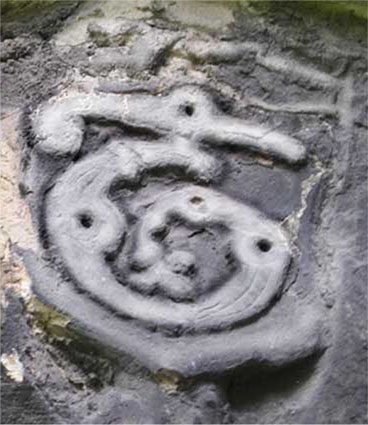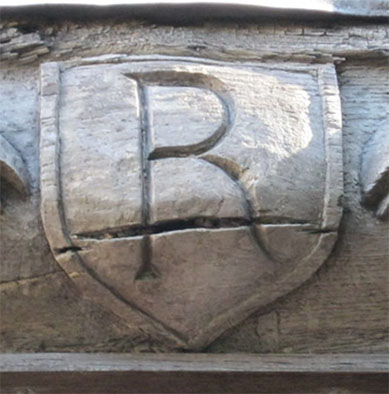- Screen Colours:
- Normal
- Black & Yellow
– a walk with Borin Van Loon
St Stephen’s Church was the starting point for our summer evening guided walk (May 27th): an introduction to some of the fascinating detail of Ipswich’s built heritage. The south wall of the church has a small ‘Lombardic T’, all that remains of the crest of Thomas Rush, Sergeant-at-Arms for Henry VII and VIII. ‘T’ for Thomas and the ‘R’ for Rush we found just a few metres away amidst the beautiful carvings of the old bressumer beam on the wall facing the east end of the church.


Along St Stephen’s Church Lane, we learned that the Conservative Club building was the first Freemasons’ Hall in Ipswich, its curved apse still visible through the gates. We emerged on to Upper Brook Street for a clear view of the winged wheel Cyclists’ Touring Club sign on the wall above the Age UK shop (the former Coach & Horses inn) opposite.
Walking north we noted the Eade and Johns designed building on the corner of Upper Brook Street and the Buttermarket with 1900 displayed amongst the swags of terracotta fruit and flowers above the Caffè Nero banner. The Buttermarket façade of this building has a wonderful, large art nouveau upper window, specifically designed as a photographer’s studio. Nearby is the Symonds for Kodaks sign hanging in the sky for all to see - J. A. Symonds was an early 20th century chemist. We moved on to Dial Lane to look at the fabulous Charles Rennie Mackintosh-style doorway of Pickwick’s Café and the newly uncovered lettering “John C. Scarborow Optometrist…” on the wall to its left. Emerging into Tavern Street we looked up above Carphone Warehouse at the ghost advertising of the long-gone Wootton’s Hairdressers. Beginning on the left with sensible items such as leather goods and stationery, they progress through hot baths and permanent waving to the seriously whacky high frequency treatments(?) on the right.
Along Westgate Street, the Crown and Anchor designed by Thomas Cotman, has its date 1897 and also its name carved twice into its limestone façade – the pierced capital letters above the coaching-door are a particularly impressive use of the limestone. And the old Grimwade’s building on the corner is also dated – a lovely interlinked 1904 above the side door on the Cornhill. From here we walked through Lion Street with its four street signs to Museum Street, pausing to find the architect’s sign above the door of no. 36, ‘R C Wrinch ARIBA Architect 1906’. Then looking opposite at the ‘F’ for Frasers on the cast iron rain hoppers of the 1920s building designed by Eade and Johns after the Frasers fire. Along Princes Street there is another architect’s sign, this time on Britannic House, ‘Geo. W. Leighton 1901’, next to the elegant arched window he designed. And so we moved to finish at the fabulous Mutual House, another Cotman building, with the gold, chiselled lettering of the original Parr’s Bank Ltd newly revealed on the green metamorphic rock cartouche of its Princes Street façade.
Thank you for a most interesting evening, Borin; we learned how much evidence visible on today’s buildings can tell us about our town’s history. [www.ipswich-lettering.co.uk]
Caroline Markham